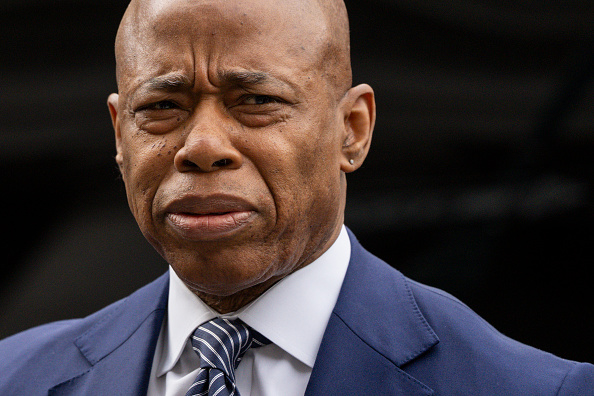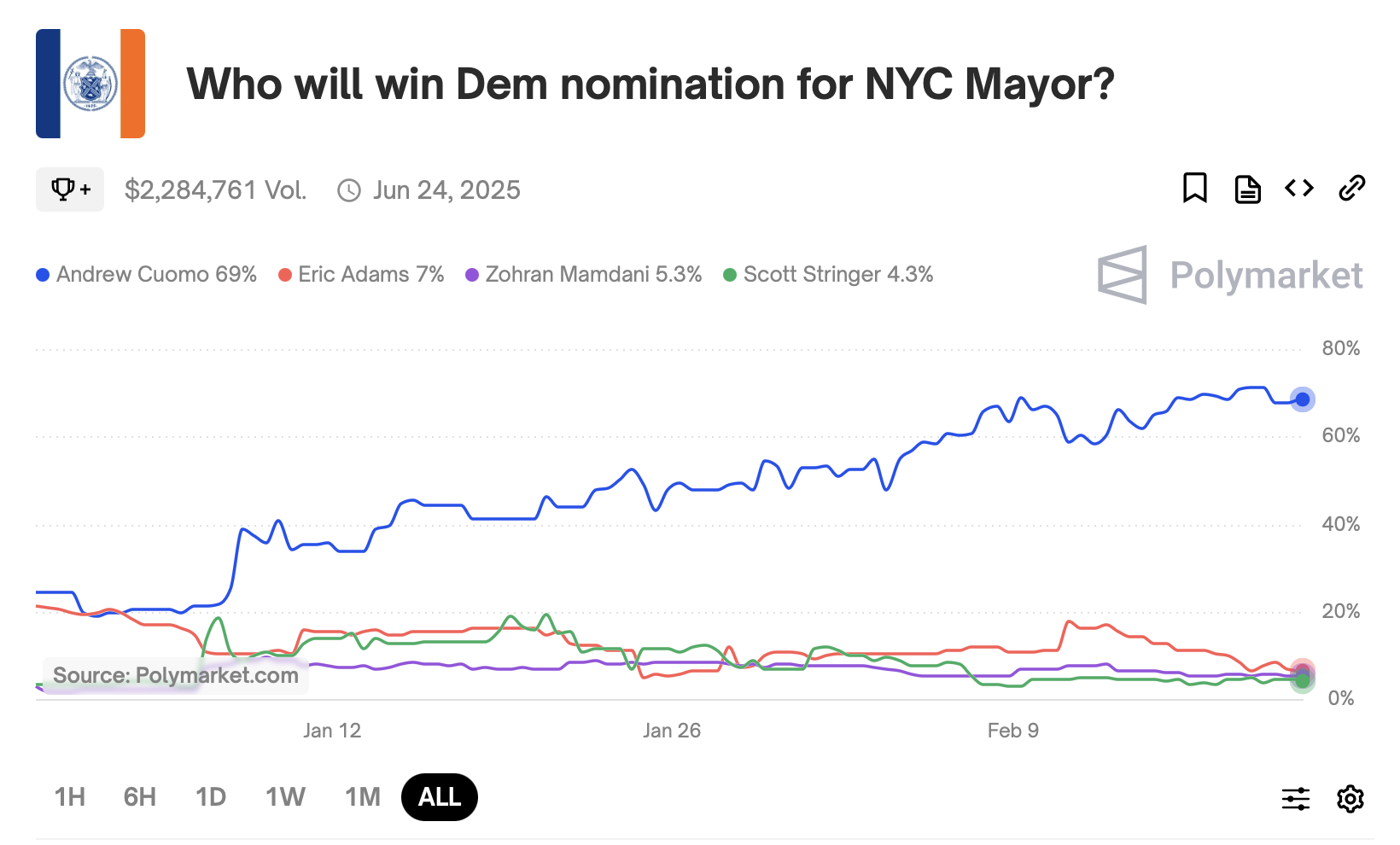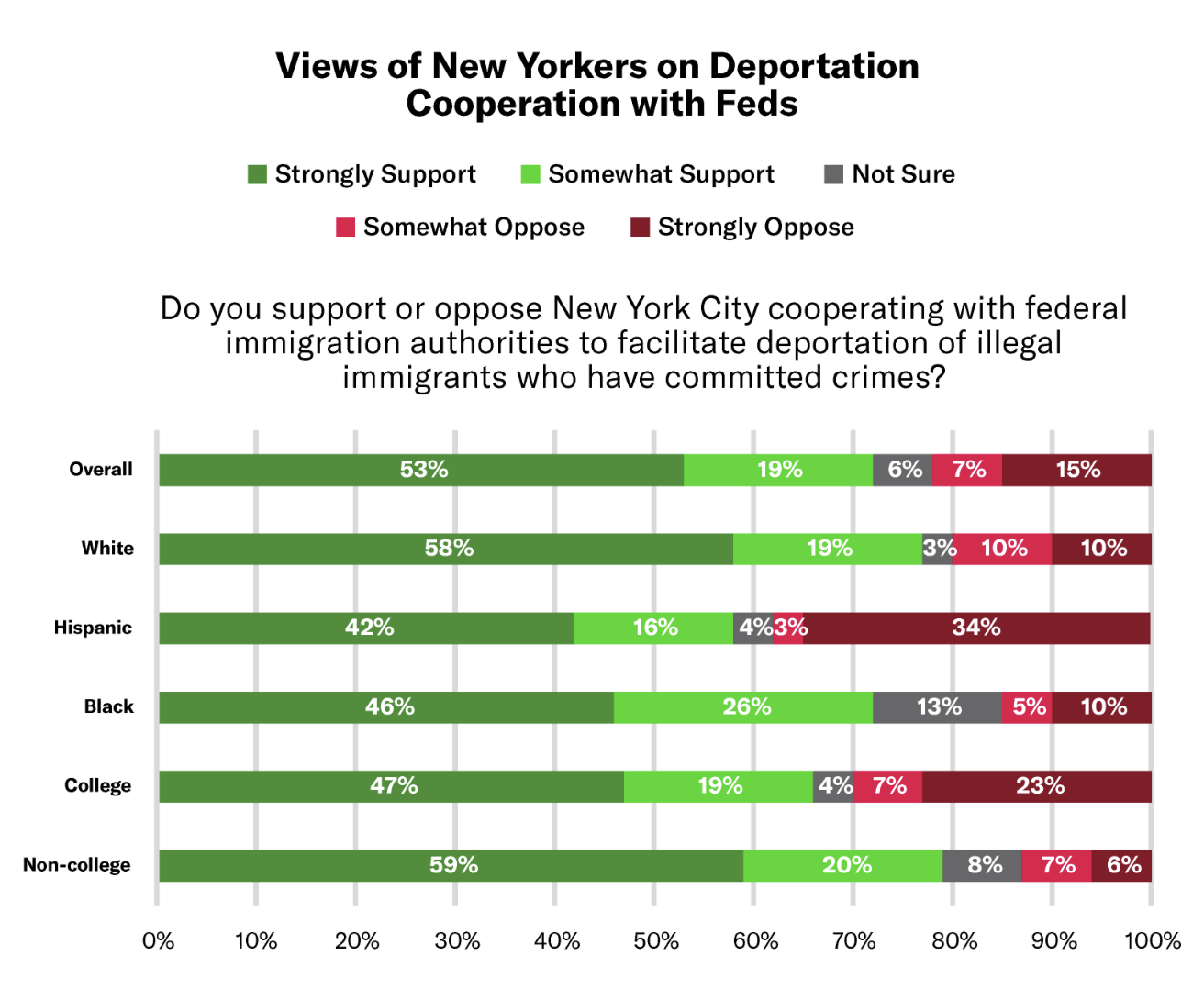|
Forwarded this email? Sign up for free to have it sent directly to your inbox.
|
|
|
Photo Credit: Eduardo Munoz Alvarez/Getty Images |
Welcome back to The Bigger Apple! It’s 18 weeks until the primaries on June 24, and the politics of New York City could hardly get more intense. We’re following the mayoral campaign, and keeping our eye on how candidates’ proposed policies will shape the future of our city. Thoughts, questions? Email me. And thank you for reading! - Liena
|
|
|
The Adams administration continues to be rocked by new developments related to his federal corruption case. The Trump administration’s pitch to dismiss his corruption case is now in the hands of Judge Dale Ho — and he may have ruled by the time you read this.
Meanwhile, four of eight deputy mayors resigned this week and calls for Adams to step aside or be removed intensified across the Democratic establishment. Gov. Kathy Hochul could have removed the mayor, a power no New York governor has ever exercised, but decided Thursday afternoon not to do so — for now. Instead, she wants to create guardrails to keep Adams, and potentially future mayors, in check. Adams sounded resigned to accepting the deal in his statement.
Comptroller Brad Lander, a mayoral candidate who was planning to convene the never-before-used Inability Committee if the Mayor did not have a plan to stabilize his administration by Friday, seemed pleased with new powers his office may gain. Everyone is still meeting with everyone else to decide what to do next and discuss the potential implications of the governor's proposal, which is still subject to approval by the city and state legislature.
But let’s put aside all the serious problems Adams is facing and consider whether removing Mayor Adams one way or another, is in the best interest of the city right now.
Adams gains nothing from quitting, and has been adamant that he’s not quitting, even invoking God’s will. All attempts to remove him are likely to be lengthy and distracting all parties involved from other duties, not to mention precedent-setting. The primaries are in June and the election is in November, so if — as looks increasingly likely — Adams remains in place, we are talking about ten more months of the Adams administration.
Would ten more months of Adams be so bad that the messy alternative of a distracted and combative mayor running for reelection while fighting for survival, and an overwhelmed Governor putting out fires left and right while fighting with the Trump administration, seems preferable? I covered Adams as borough president and was never optimistic about his mayoralty — but the case for removing him isn’t clear.
And Adams’ policies, which he has been attempting to carry out, however clumsily, are actually in line with what the voters in this city want. Our polling shows they overwhelmingly want unauthorized immigrants who commit felonies deported. They want seriously mentally ill individuals in distress to be moved to care, whether they want it or not. They want more cops on the subways, and criminals locked up. They want more housing — his City of Yes is popular. Where he has failed is in delivering on his most important promise — to be a law-and-order mayor and keep the residents of this city safe.
But not everyone is abandoning their mayor: Establishment Democrats, rabbis and pastors are standing by him, threatening to punish anyone who forces Adams to quit without going through the legal process. Hochul, up for re-election herself next year, listened.
“Adams has lots of flaws and he did himself no favors with his preference for corrupt people,” NYU Professor Mitchell Moss, a former Bloomberg advisor and a longtime observer of city politics, said in an email. "But New Yorkers care about the mayor in deeper and more complex ways than the media understands."
|
The Democrats seeking to replace Adams are talking about the mayor — and looking over their shoulders at former Gov. Andrew Cuomo, who appears very likely to announce a run within weeks. All of his opponents have been calling for him to step down or be removed, and the feeling is shared across much of the Democratic Party spectrum, with even the more moderate Rep. Ritchie Torres telling CNN that Adams is running a “Vichy administration.”
The Democratic machine that elevated Adams, meanwhile, is already looking for someone else to support, and City Council Speaker Adrienne Adams is being floated as another candidate to potentially enter the race. It’s hard to see another Adams going anywhere — but she might give her supporters something to trade in a bargain to endorse Cuomo.
Cuomo will, of course, bring his own drama: He just lost his case to blow up the New York State ethics board, which is investigating his $5 millin COVID book deal.
But I wouldn’t bet against him, nor would most of the gamblers on Polymarket: |
At the heart of the Adams crisis, setting aside his legal troubles, is the mayor’s willingness to collaborate with the Trump administration to implement its immigration policy in a city where about half a million residents lack legal status. These individuals comprise a large share of workers in construction, childcare, eldercare, restaurants and food delivery, and deporting them all would come with real economic costs, according to a comptroller report.
Immigrant communities are on edge, uncertain about what exactly is about to happen, especially when it comes to ICE enforcement at schools, hospitals, places of worship, or jails. Advocates also worry that the Trump administration’s immigration enforcement will sweep up migrants indiscriminately, regardless of their status, deporting them just because they don’t have the correct papers. This week, a group of 70 rabbis, clergy and liberal Jewish organizations sent a letter urging Adams and Hochul to denounce mass deportations.
The city’s current sanctuary laws were enacted in 2014 in part to increase cooperation between undocumented residents and the police without fear of deportation and to counter the Obama administration's aggressive immigration policies.
In theory, the laws don’t limit all cooperation between the city and ICE. In practice, however, virtually nobody seems to be getting deported that way.
Between October 2012 and September 2013, the city transferred more than 3,000 people to ICE, the New York Times reported in December. In the year ending June 30, 2023, the city transferred just 10 people, “all of whom had been convicted of violent or serious crimes” according to an annual report.
Whether this change has made NYC less safe is hard to establish. Adams says migrant gangs are “extremely dangerous,” as Nicole Gelinas wrote last year. Yet we have no idea what share of crime in our city could be attributed to unauthorized immigrants, because the NYPD doesn’t report crime by immigration status.
“It is hard to get data that breaks out crimes committed by illegal aliens, but, as I noted in the New York Post, in the Midtown precincts straddling the migrant-filled Roosevelt Hotel, petit larcenies are up 36% year-to-date compared with 2019. In Midtown South, grand larcenies rose from 1,671 to 2,038 over that time,” Manhattan Institute’s Hannah Meyers wrote in an email.
Are immigrants more likely to commit crimes? Historically — no, experts say. But that does not mean that crimes are not being committed by immigrants, or that some of these crimes are not among the deportable offenses. The New York Post recently reported that ICE estimates over 58,000 of the city’s undocumented immigrants either have felony convictions or open criminal cases, and it suspects about a thousand could be gang members.
Our latest polling reveals that 72% of New Yorkers support facilitating the deportation of illegal immigrants who have committed crimes, while 54% say that the city's immigration policies are too soft.
“Candidates should recall that total resistance to President Trump's immigration agenda is not only unpopular, but it will make New York less safe,” says the MI’s John Ketcham. |
|
|
- People: City & State’s 2025 NYC Power 100 is out. The top three spots are Gov. Hochul, President Trump and Mayor Adams, in that order.
-
Public Safety and Crime: The city paid out a record $206 million last year to settle police and prosecutorial misconduct cases. The NYPD has already blown through its overtime budget, as it struggles to retain and hire staff, and is now considering lowering its college credit requirement to join.
- Immigration: Trump’s latest attempt to crack down on illegal immigration targets sanctuary cities and federal aid for undocumented migrants.
-
Transportation: NYC’s congestion pricing is headed for the courts after Trump revoked federal approval this week. More barges and ferries will be coming through the harbor to Brooklyn to deliver packages, with cargo bicycles replacing last-mile truck deliveries, Deputy Mayor for Operations Meera Joshi said last month. Residential parking permits won’t guarantee a spot in your neighborhood -- just a shot at trying to find one, Streetsblog’s analysis shows.
-
America does not have enough elevators because they are so expensive, writes Stephen Smith, founder of the Center for Building in North America. “Smith estimates that a new six-stop elevator that costs $170,000 to install in North America would run $60,000 or less across the Atlantic. Operating cost differences are even steeper. New York City guidelines advise affordable housing developers to budget $7,500 for annual elevator maintenance, with private housing operators in New York and Washington quoting similar numbers. This is several times European costs: one German firm, for instance, offers midrise maintenance contracts for about $450 per year.” Why? Union contracts and stringent safety regulations in the U.S. drive up the costs.
|
Try St Kilda Coffee on 44th, a minimalist basement oasis of Australian coffee and quiet in Hells Kitchen. |
|
|
A weekly newsletter about NYC politics and policy,
published by the Manhattan Institute, edited by Liena Zagare. |
|
|
Copyright © 2025 Manhattan Institute, all rights reserved. |
|
|
|






